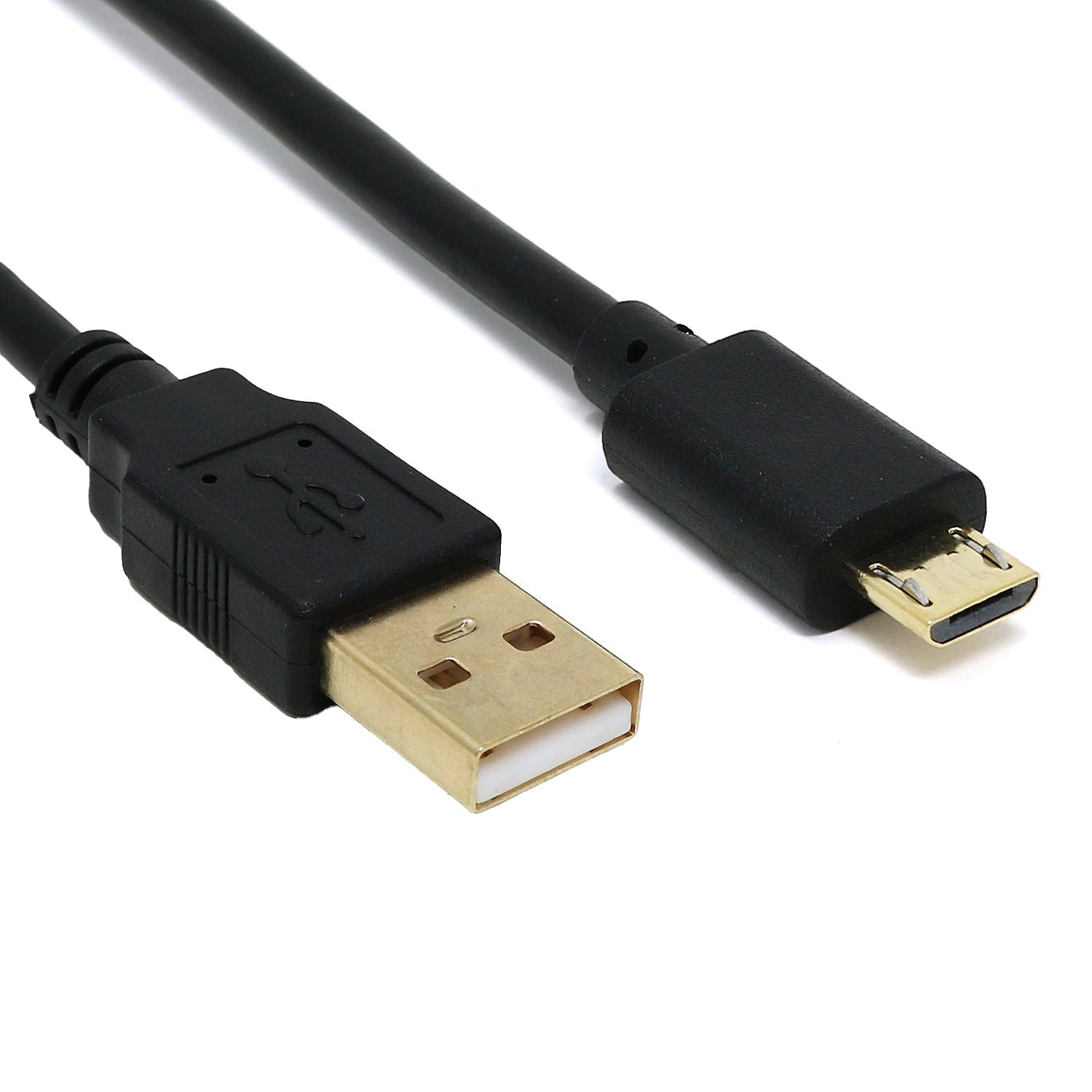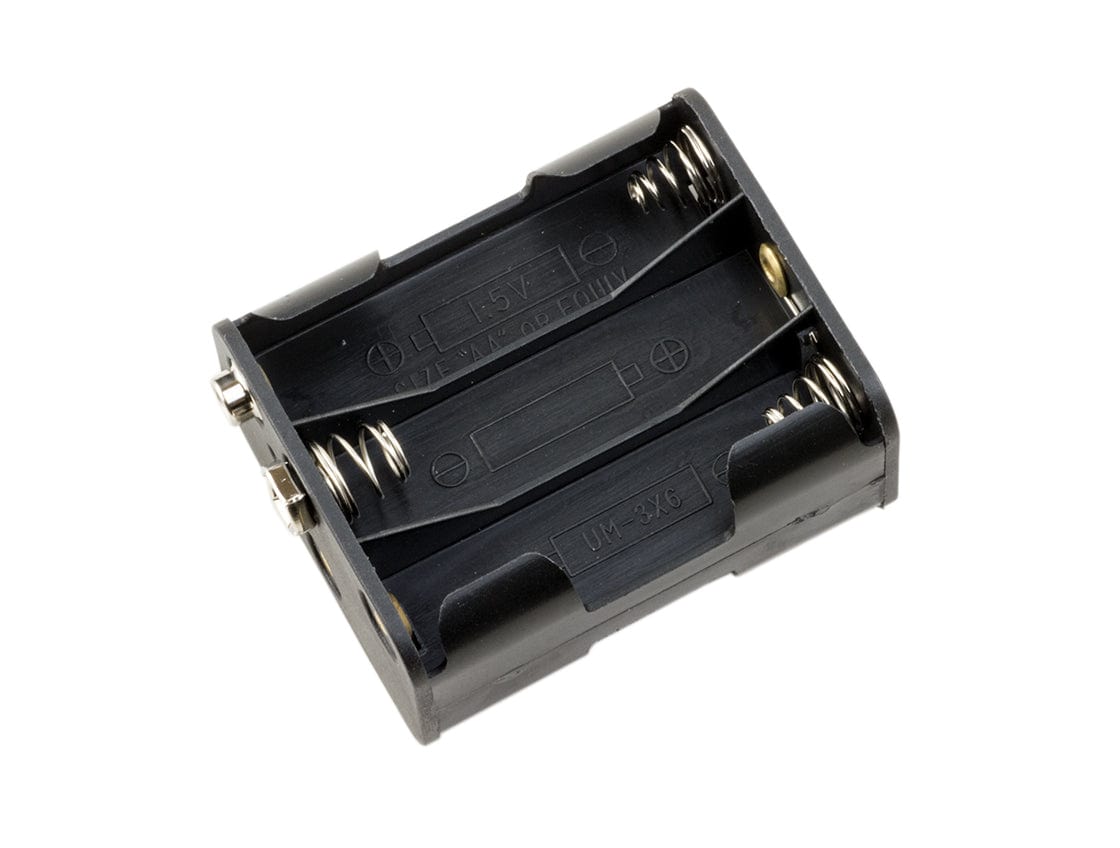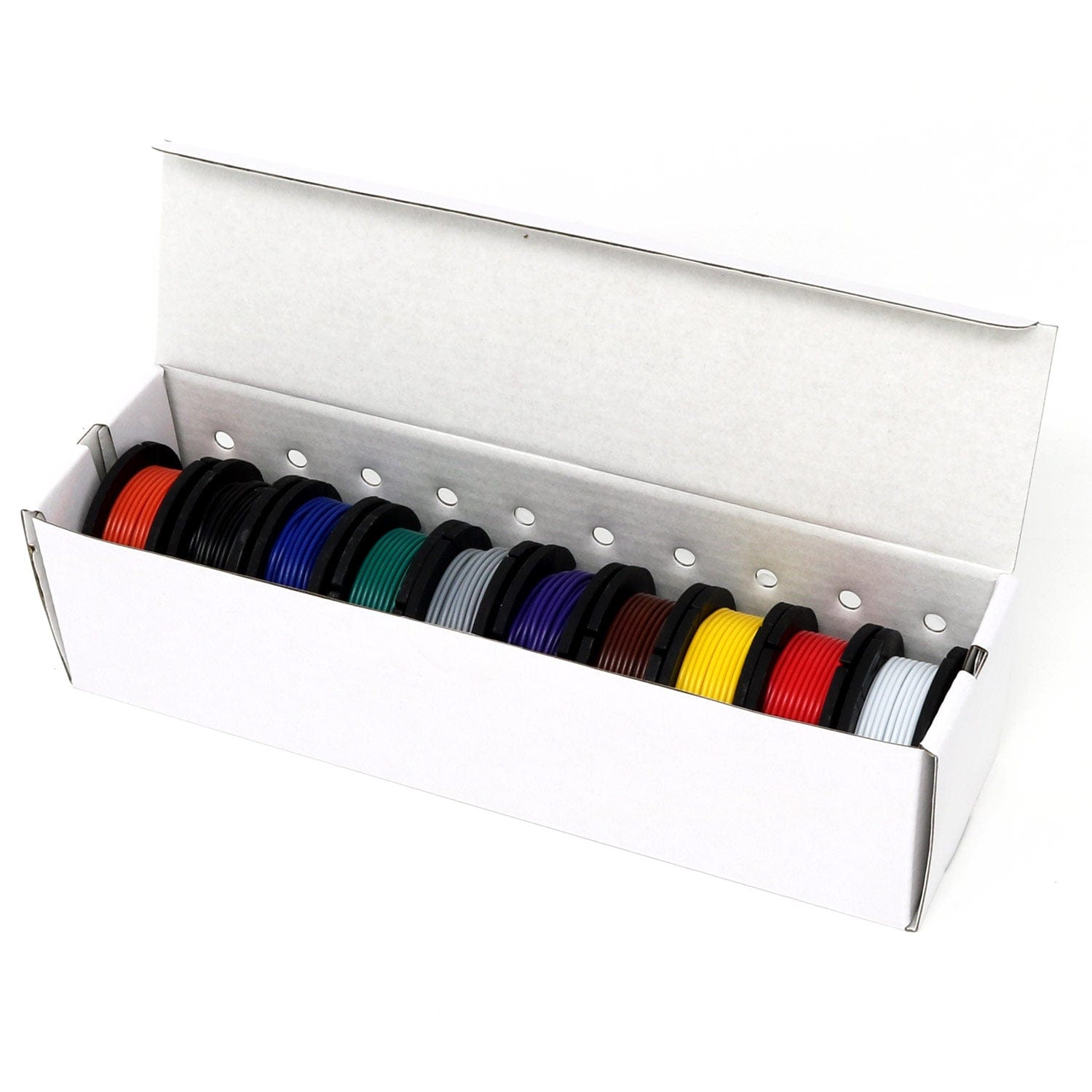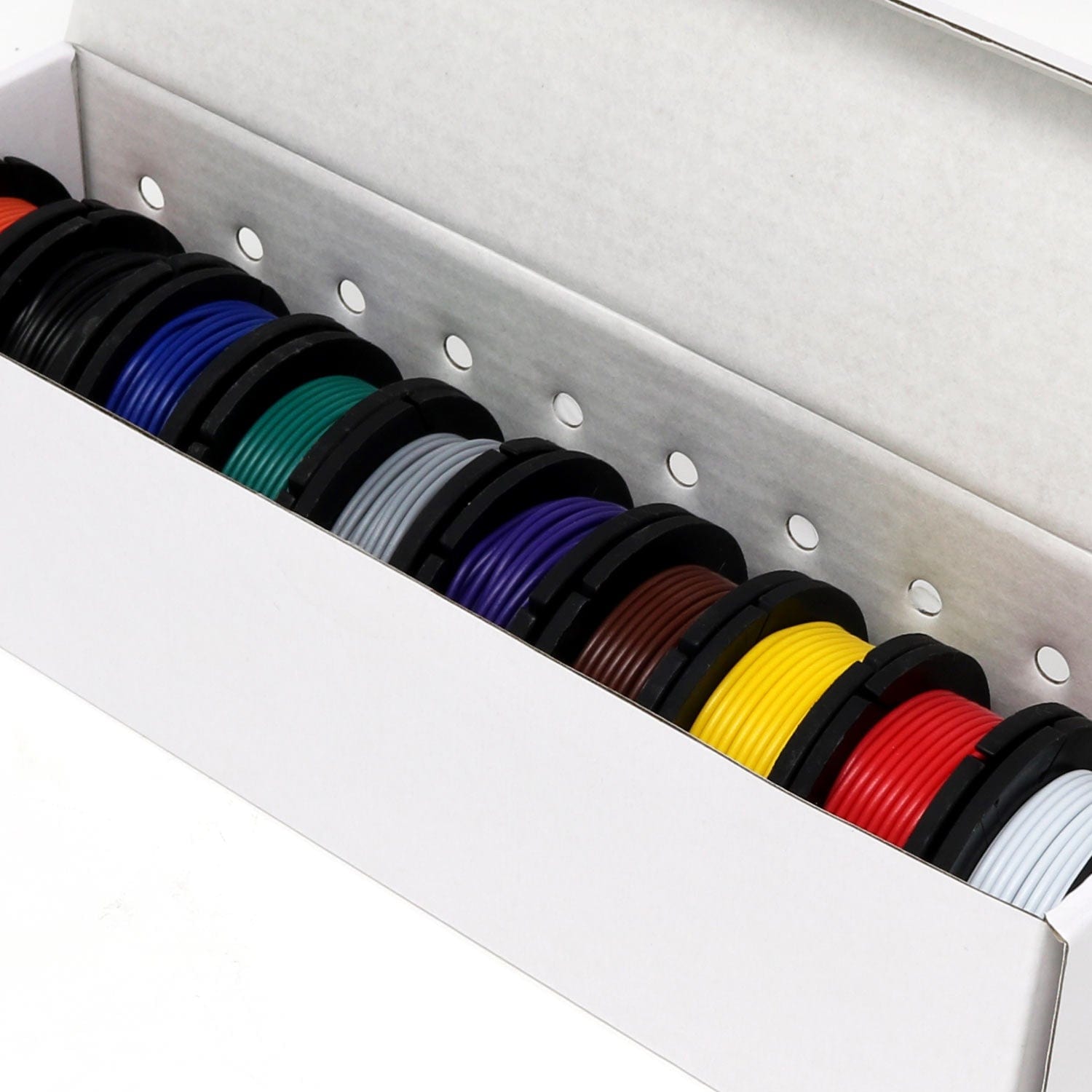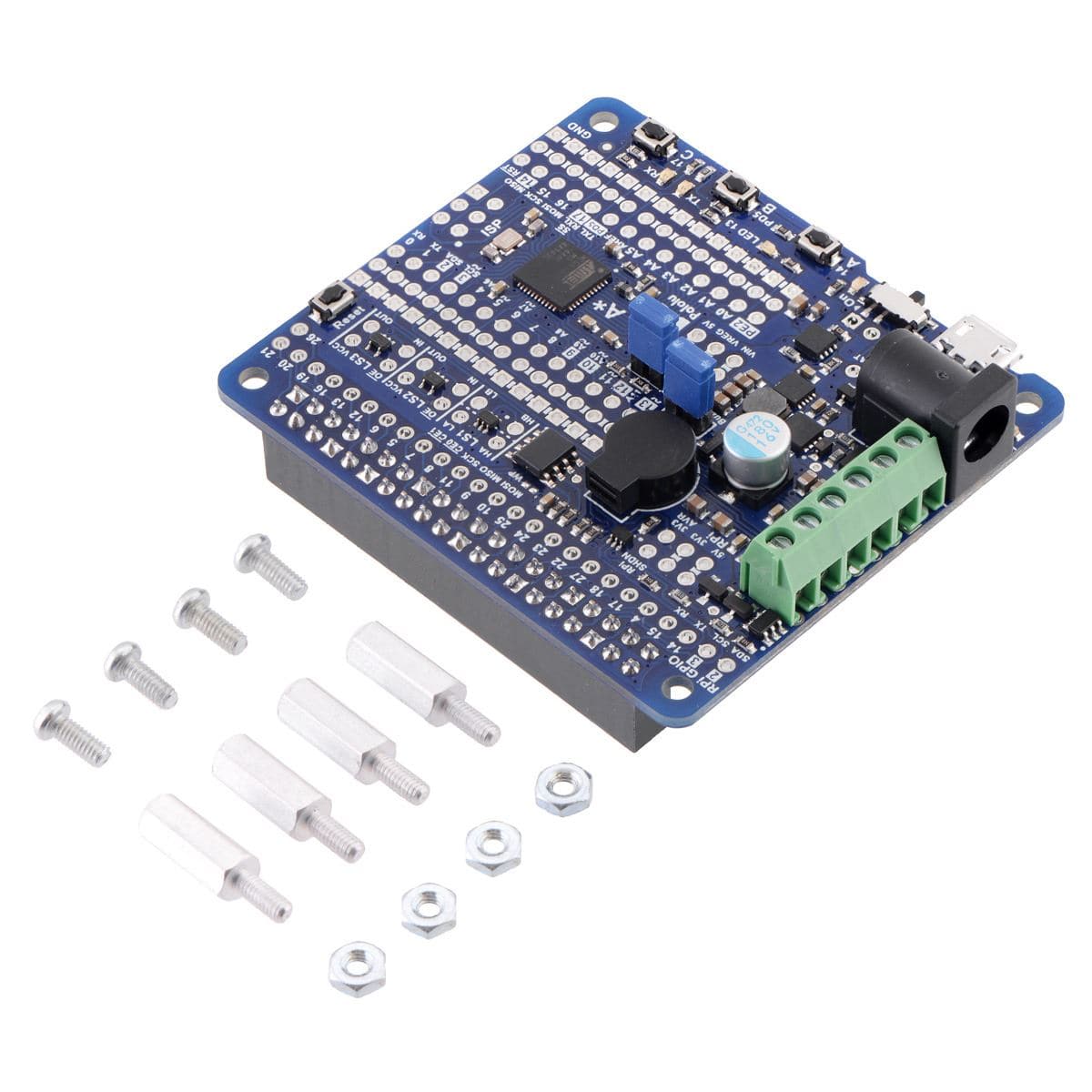
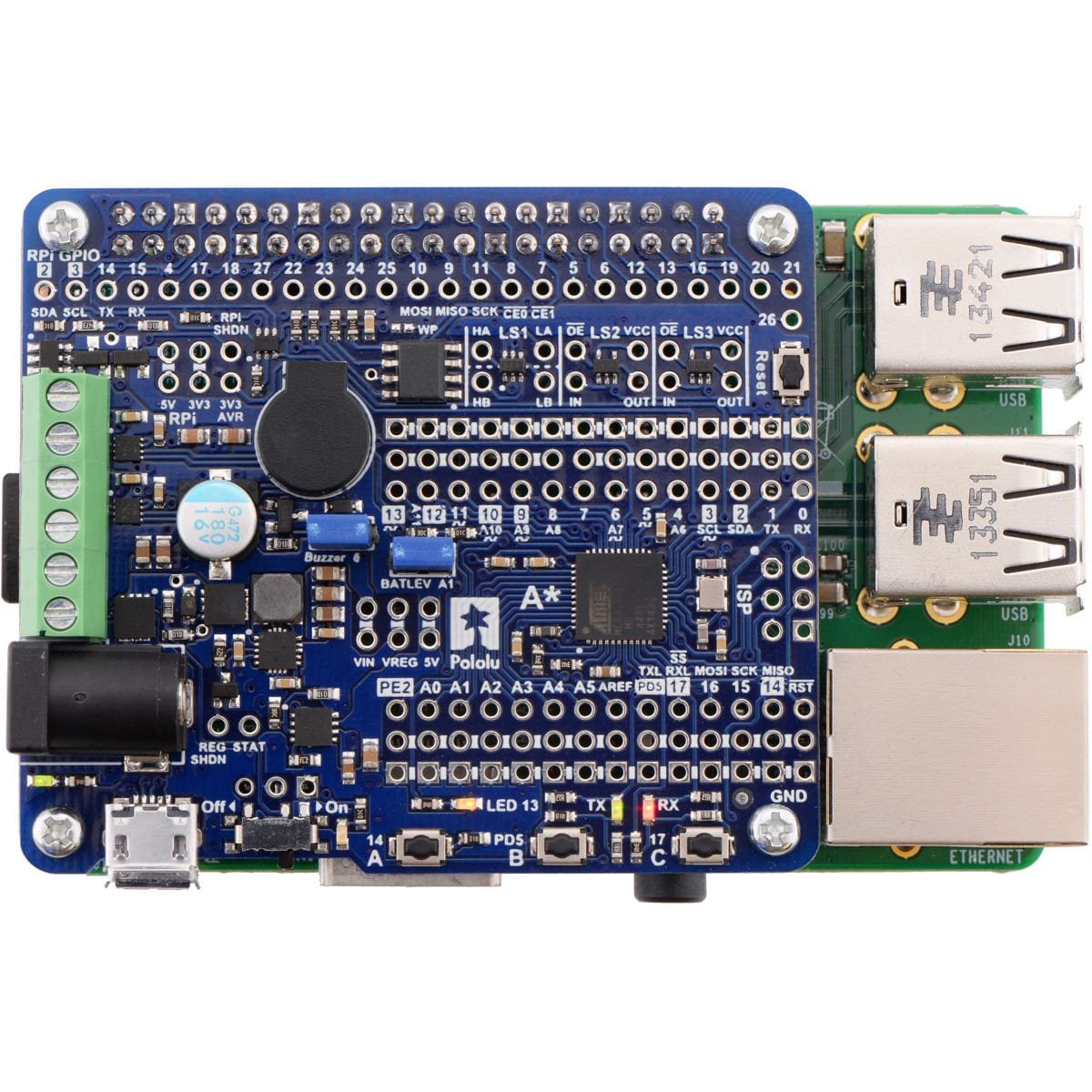
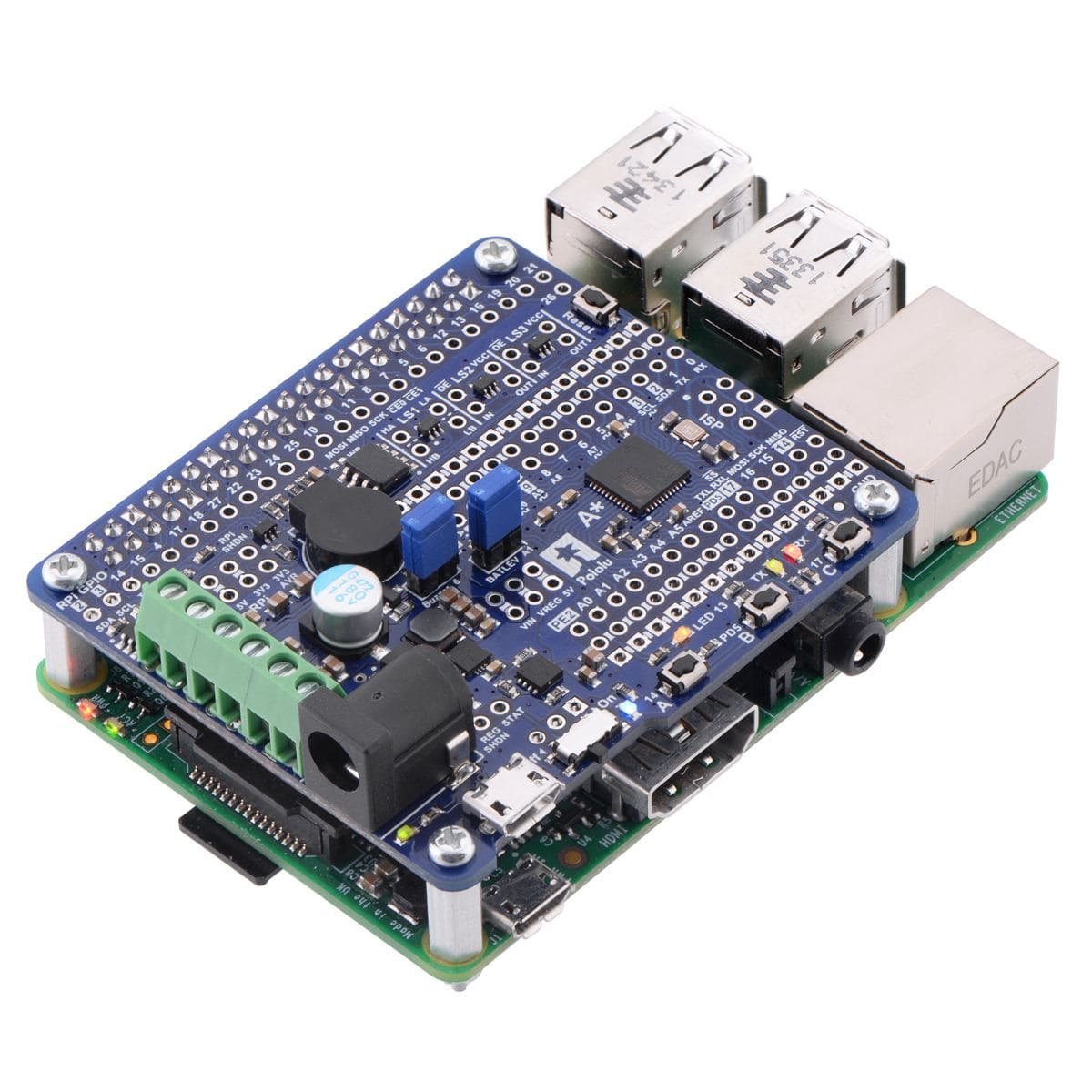
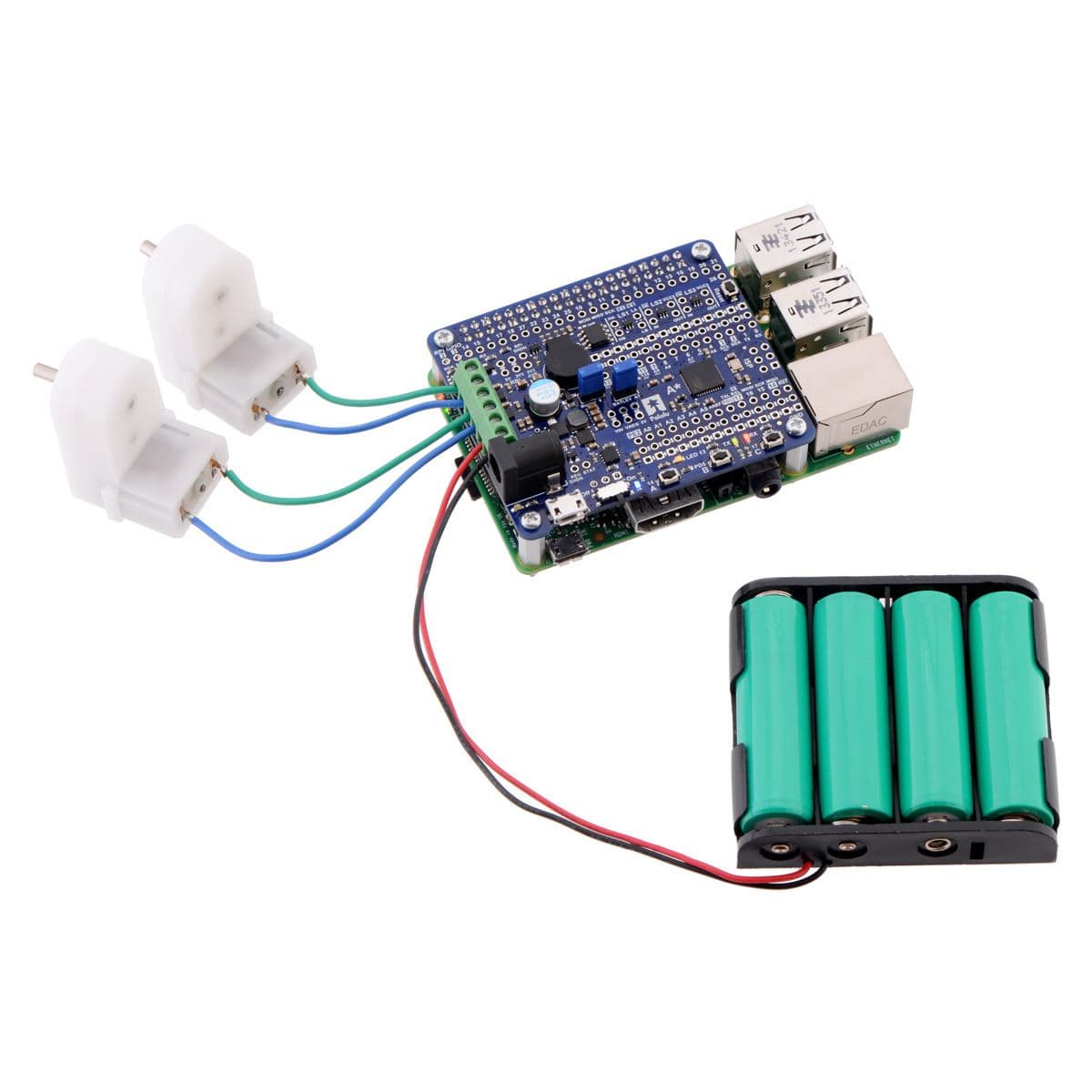
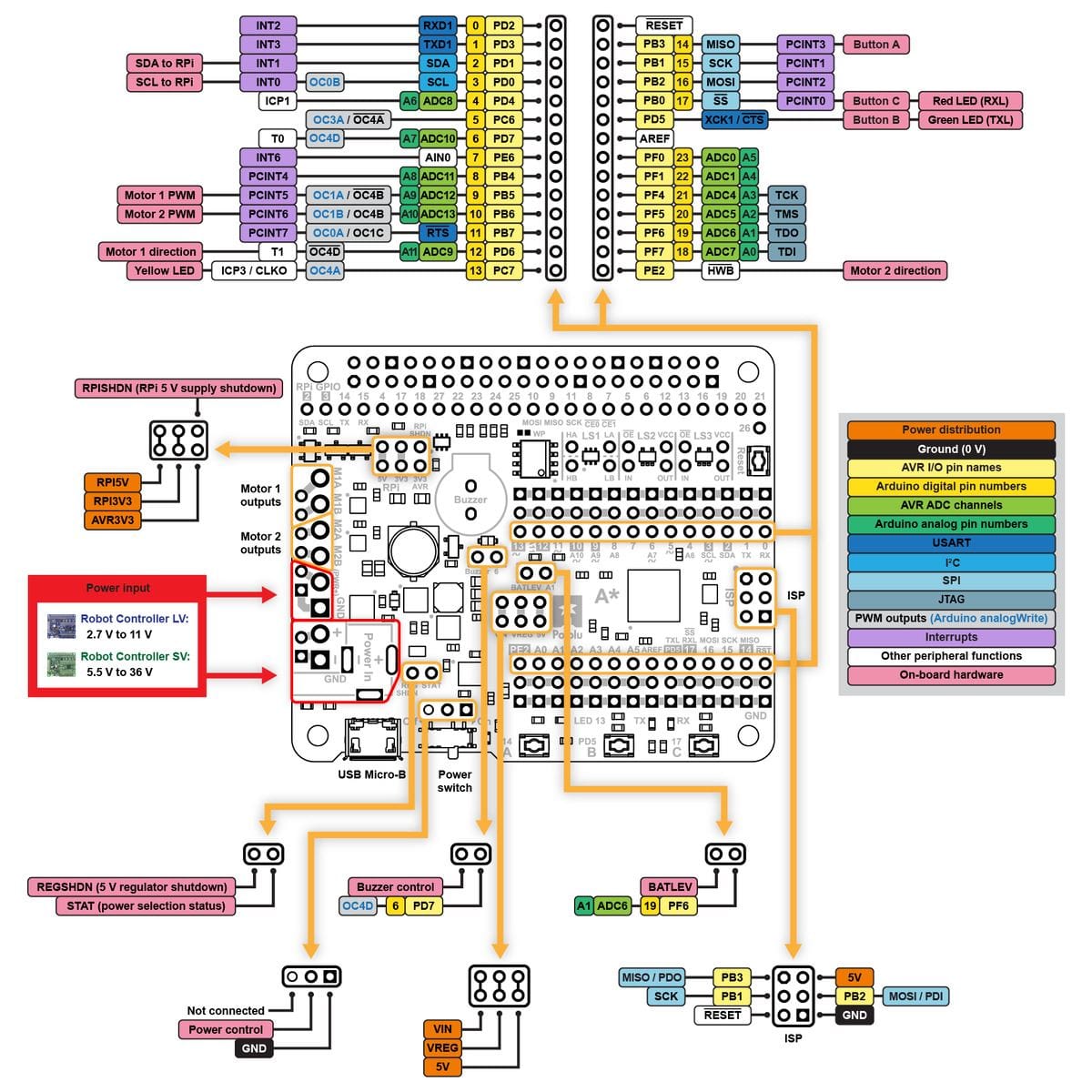
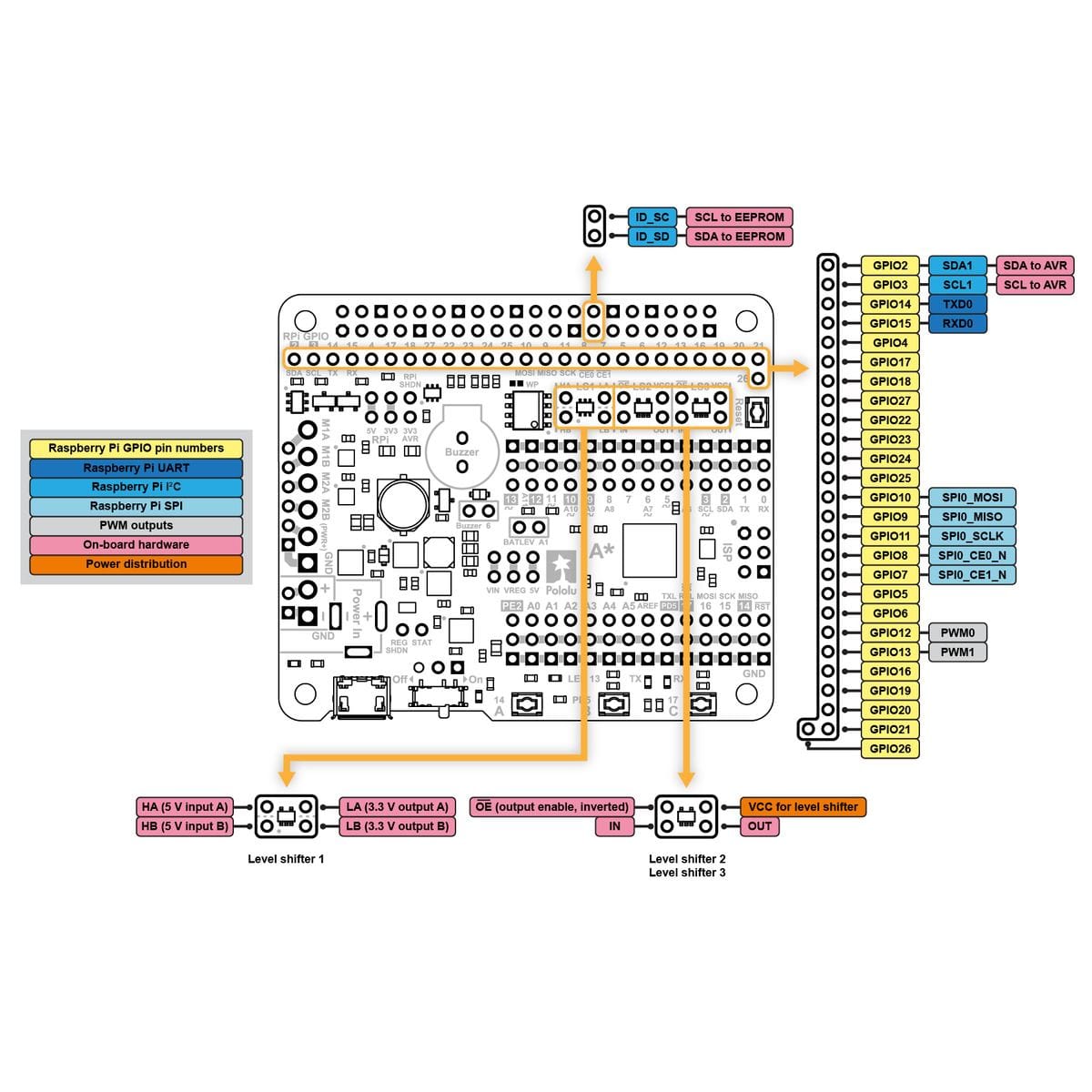
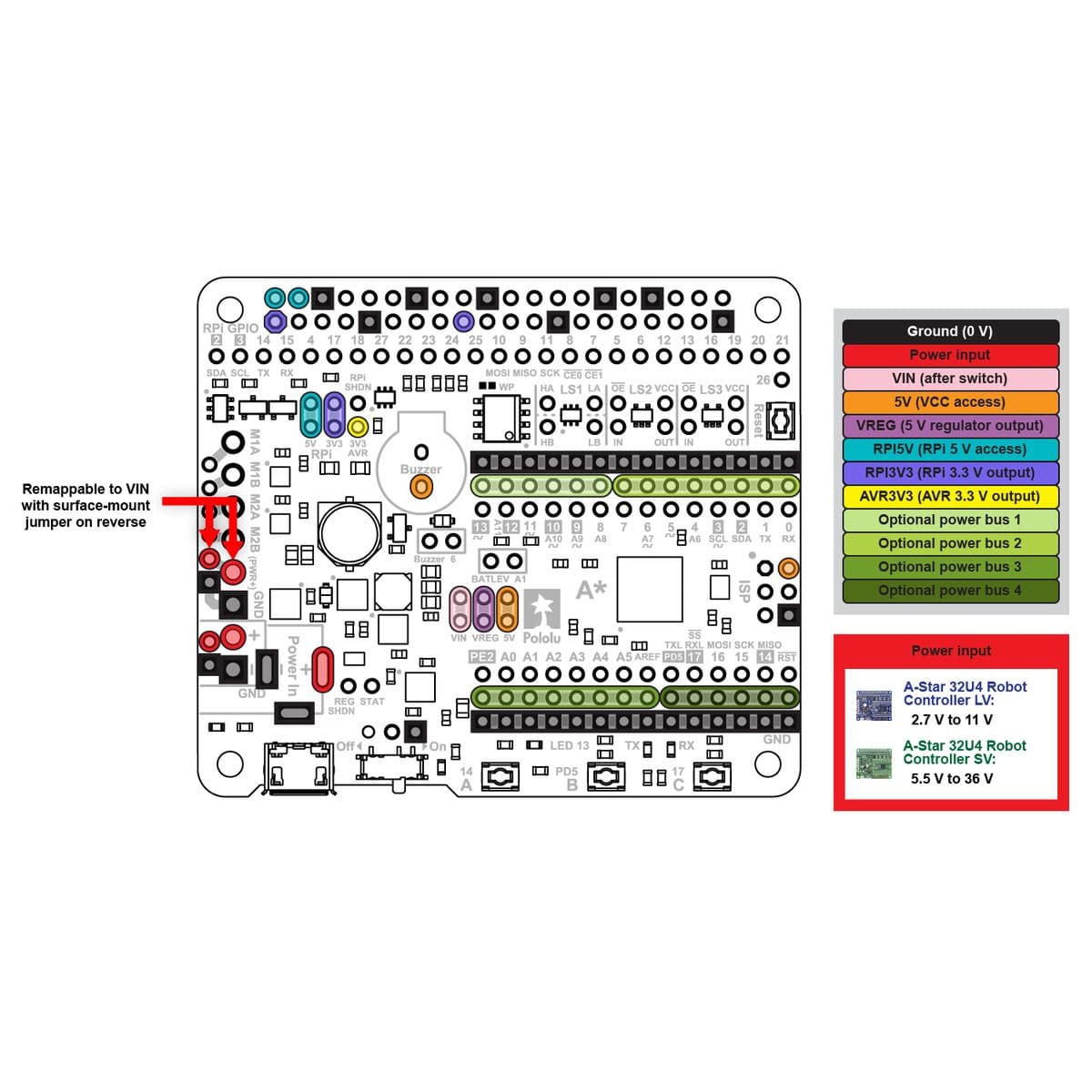
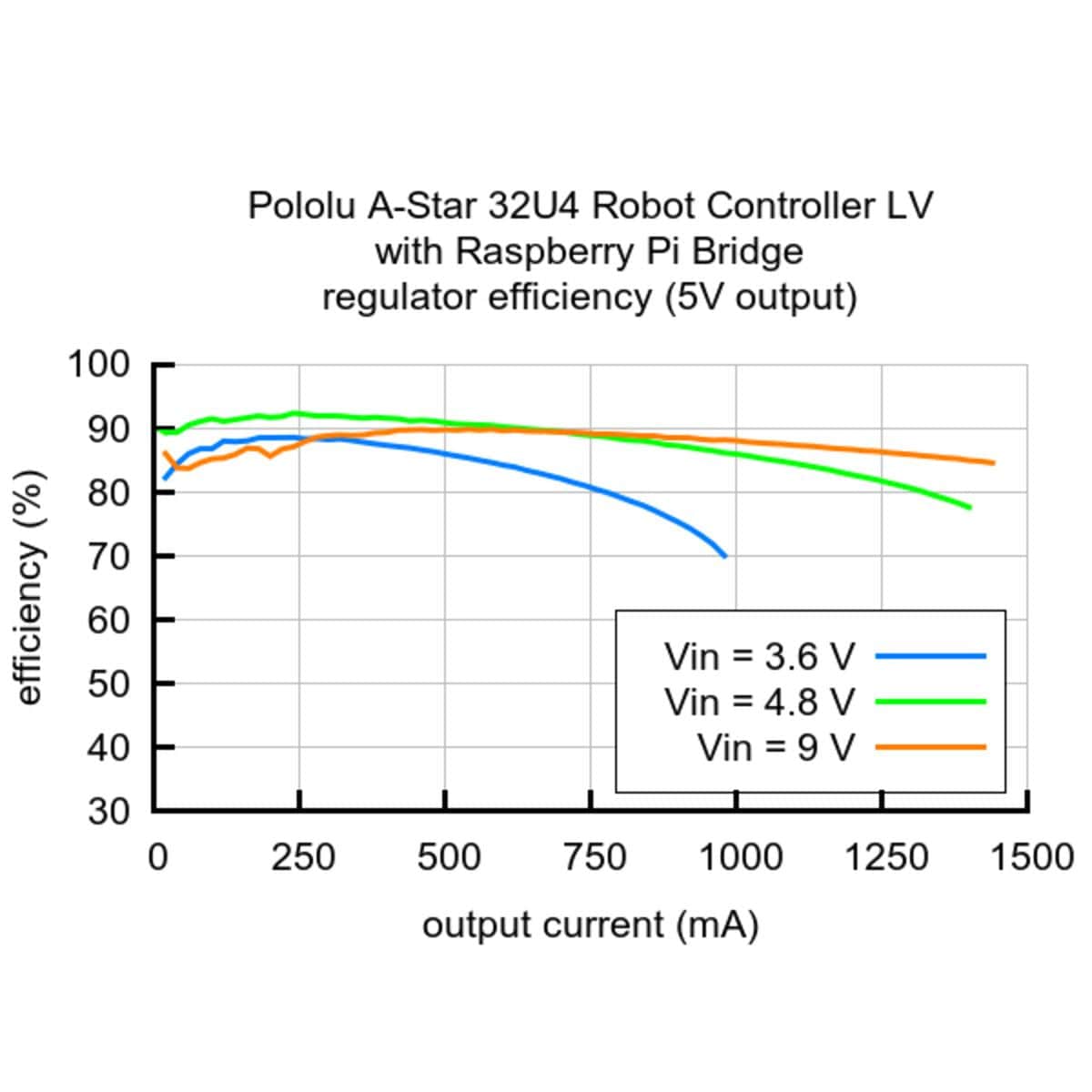
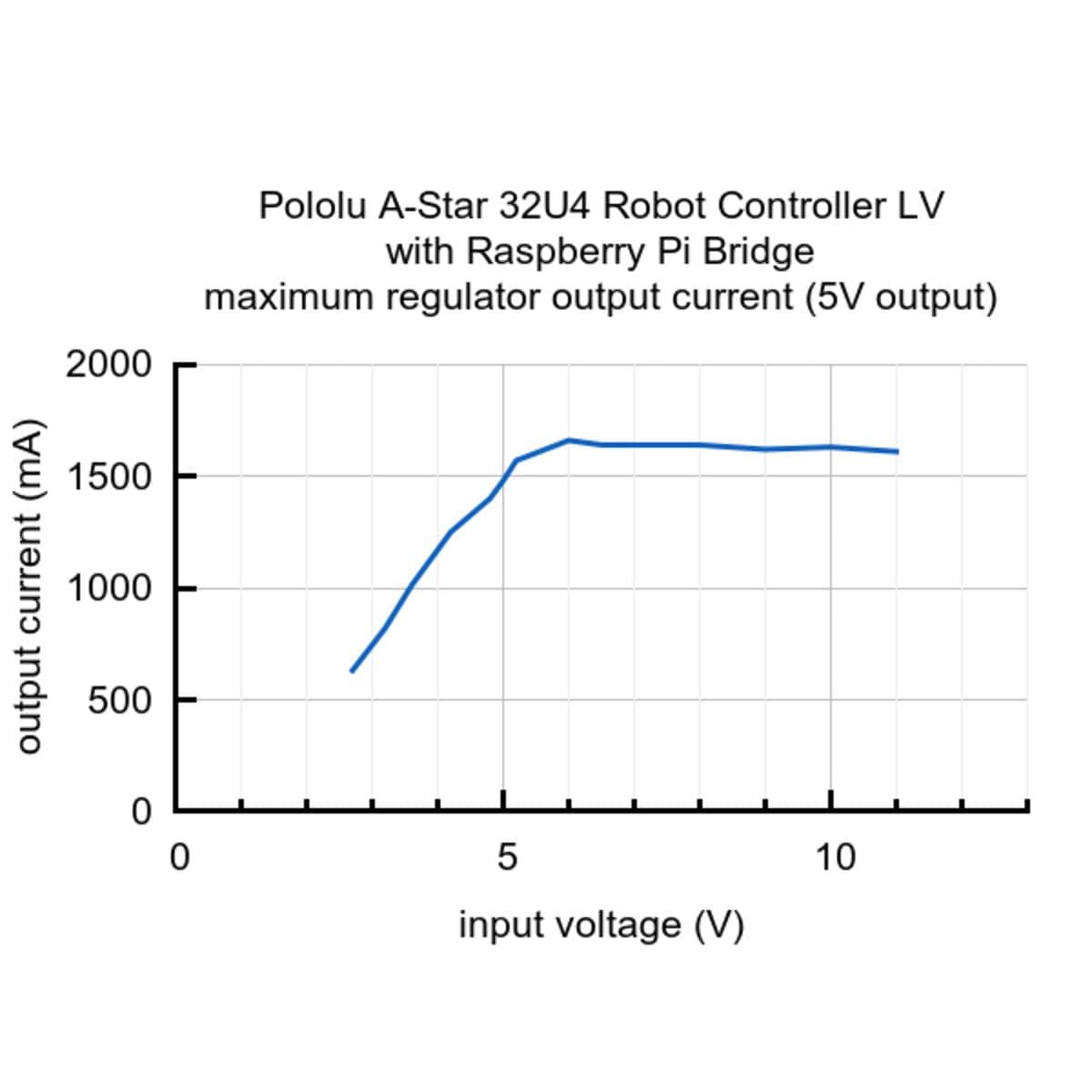
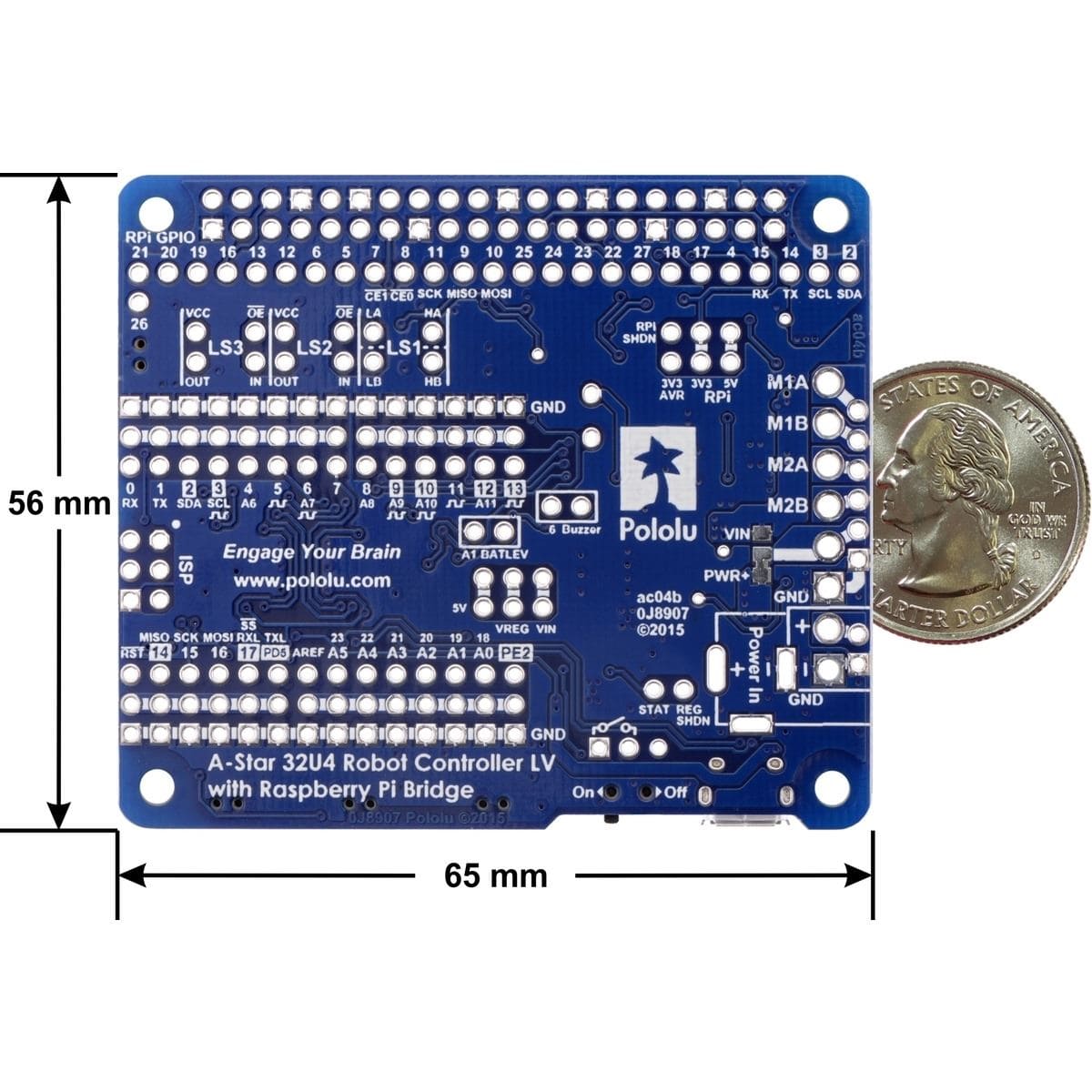
Login / Signup
Cart
Your cart is empty
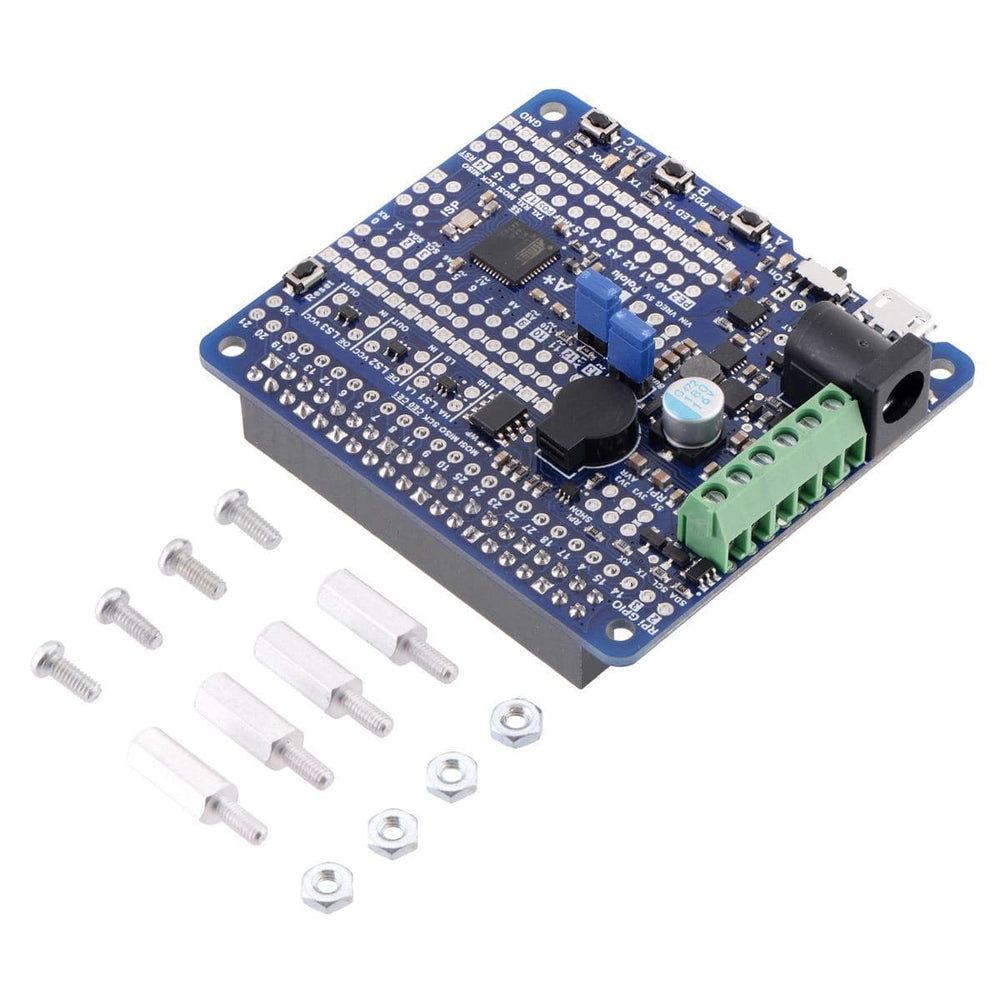
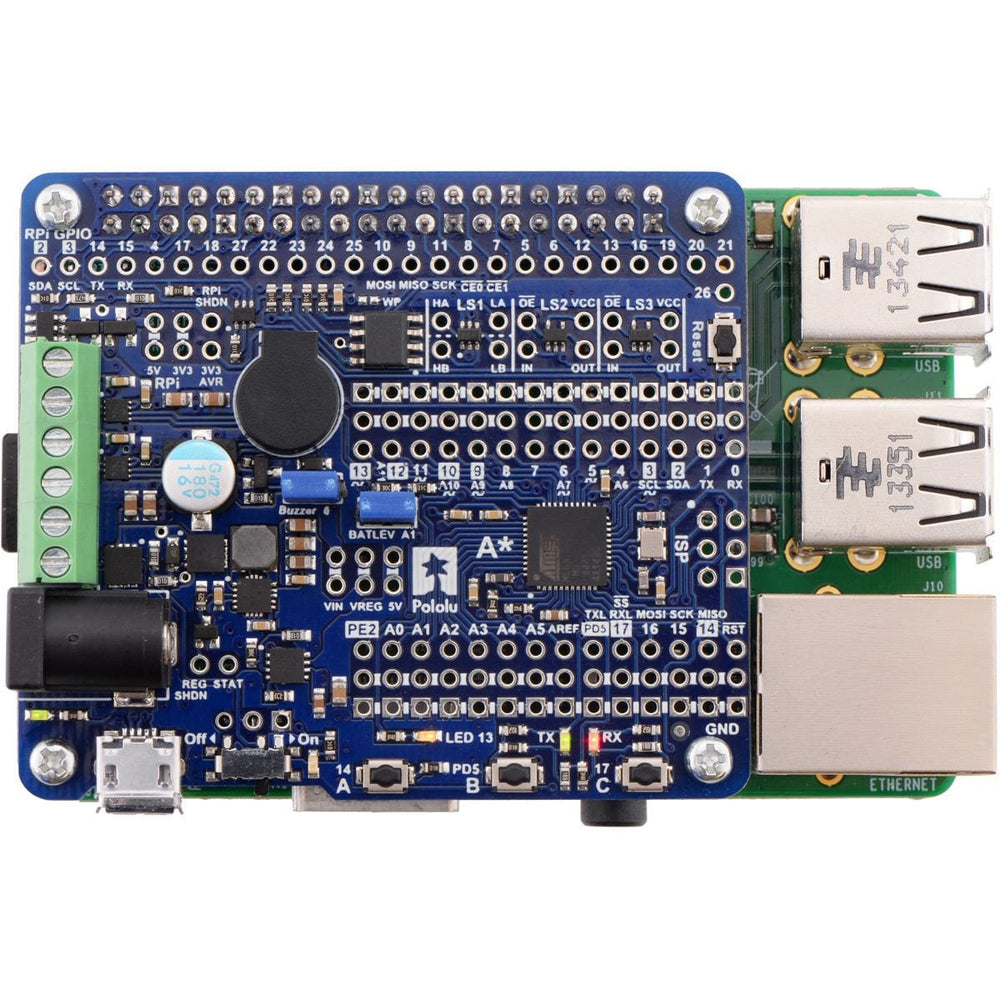
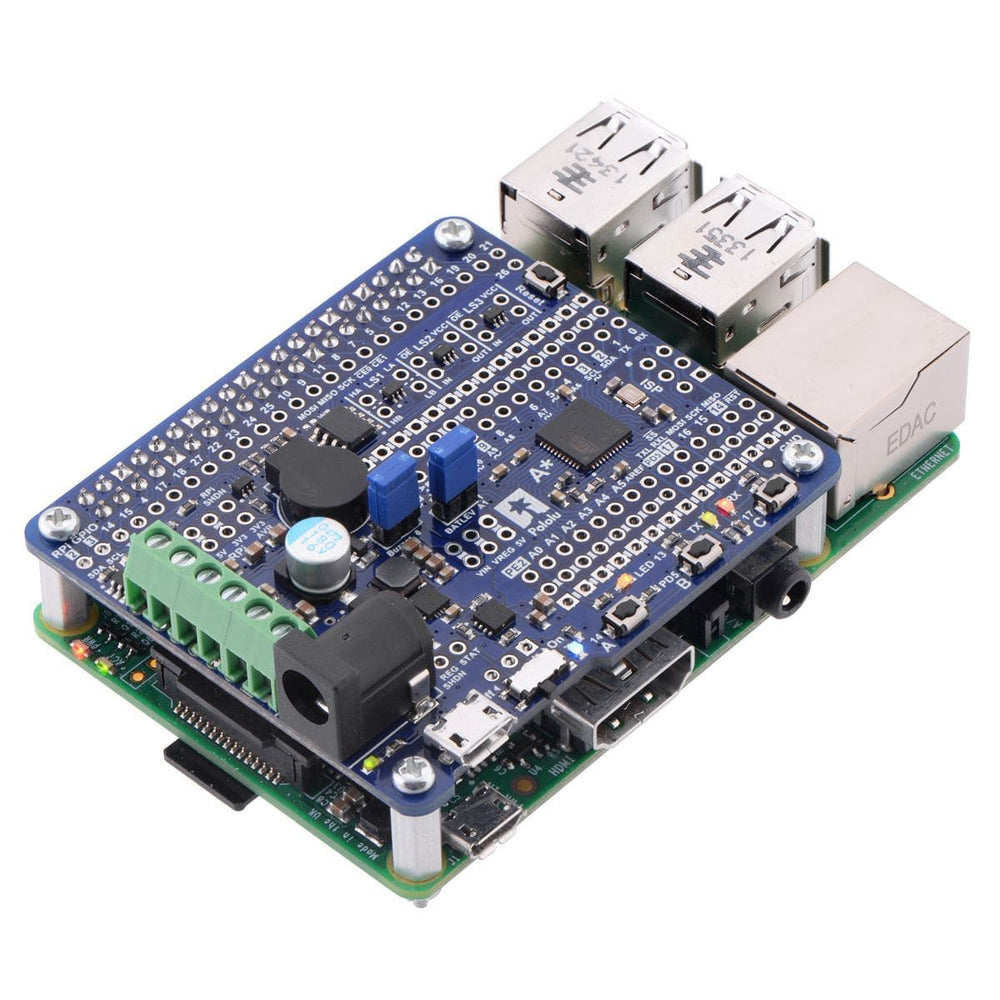
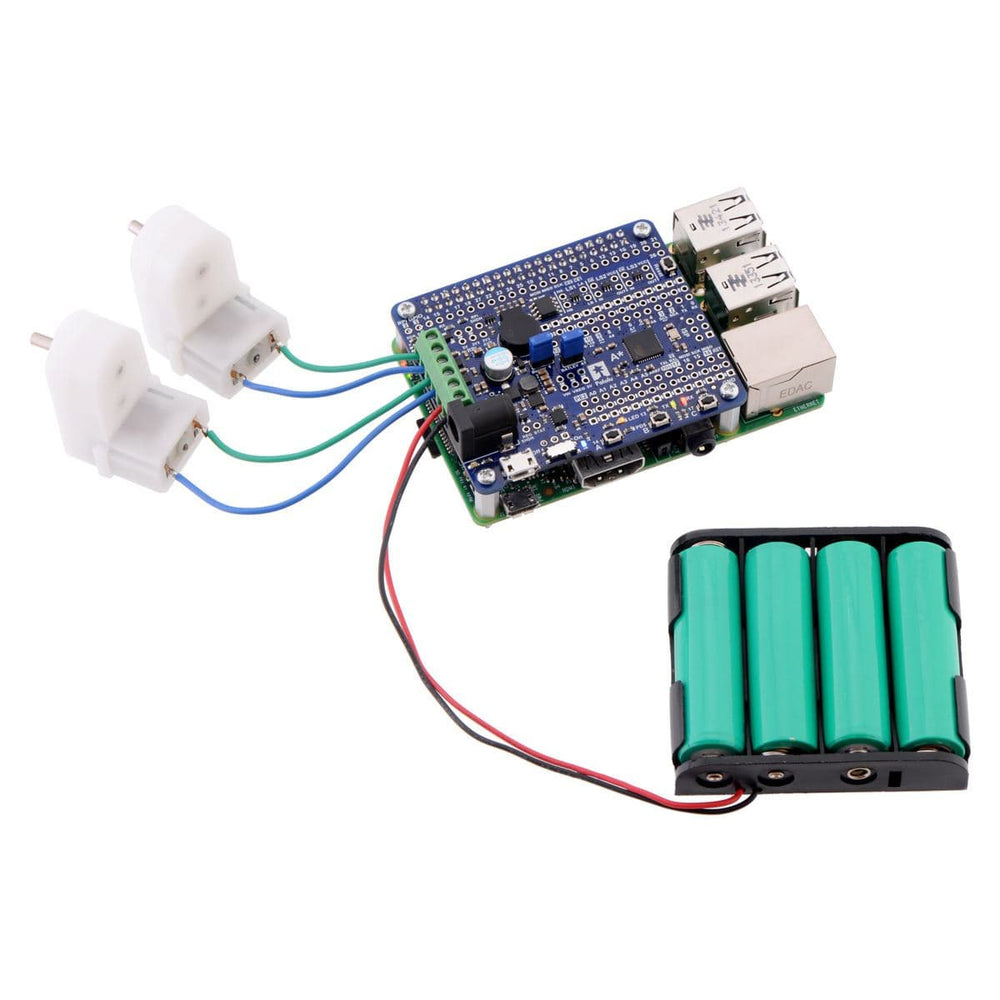
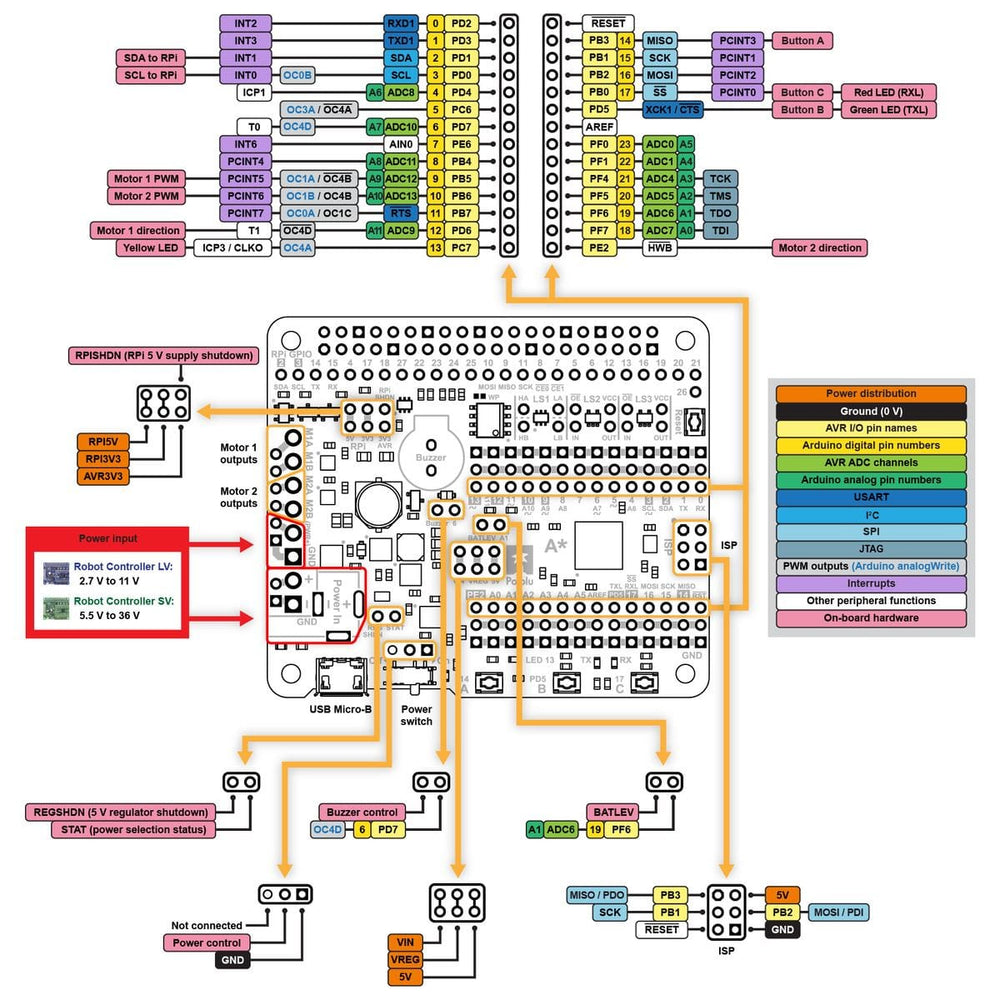
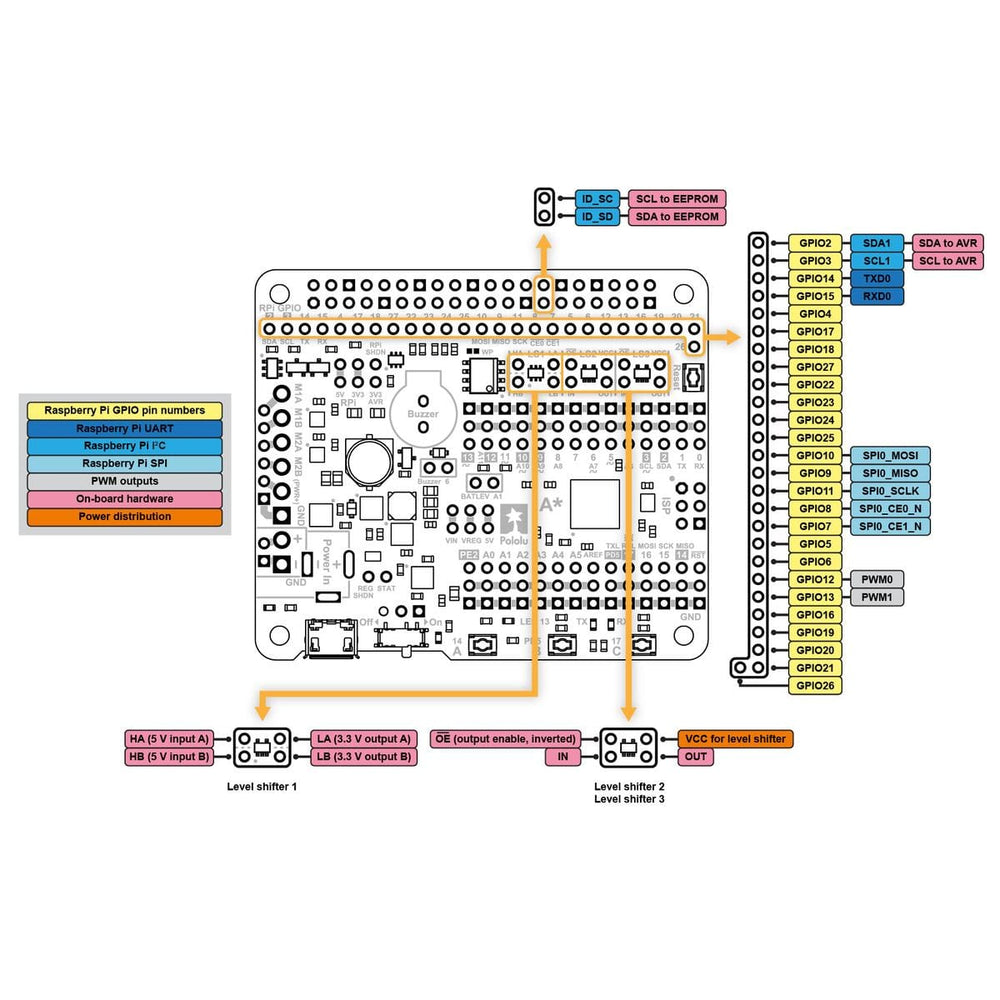
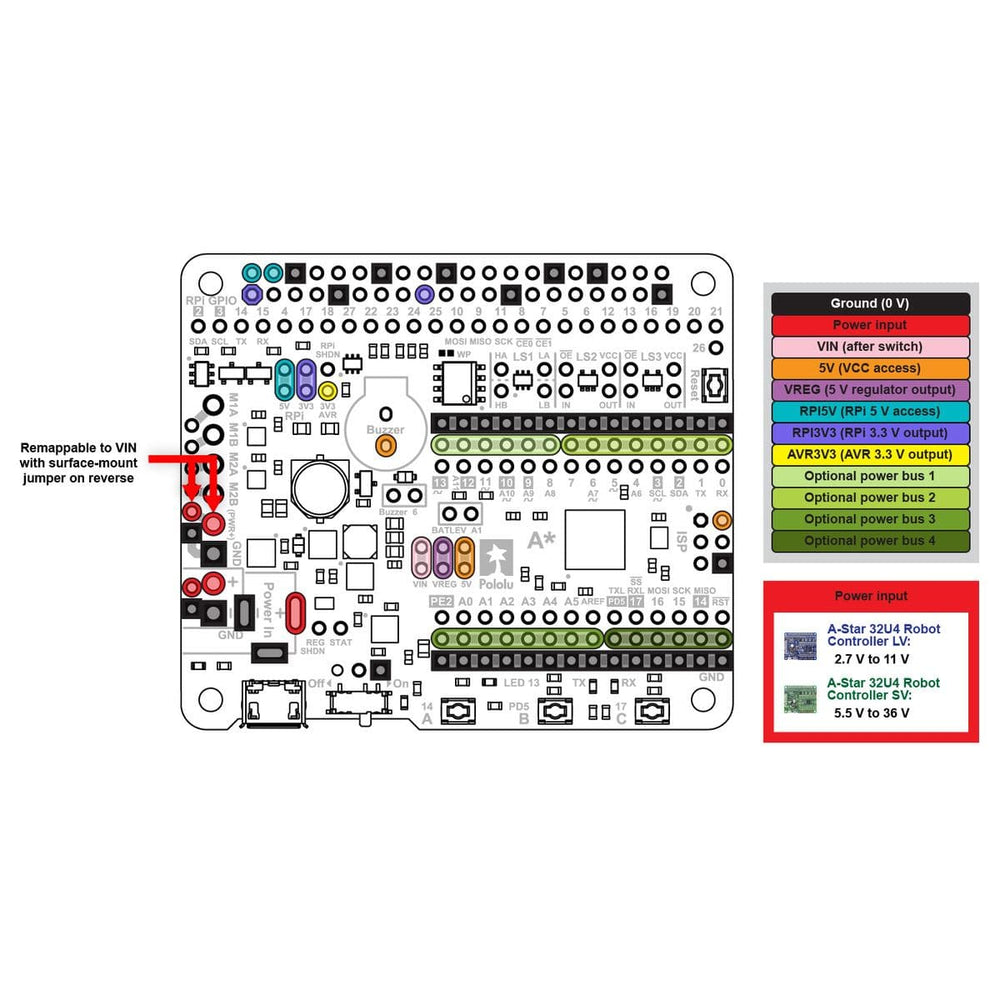
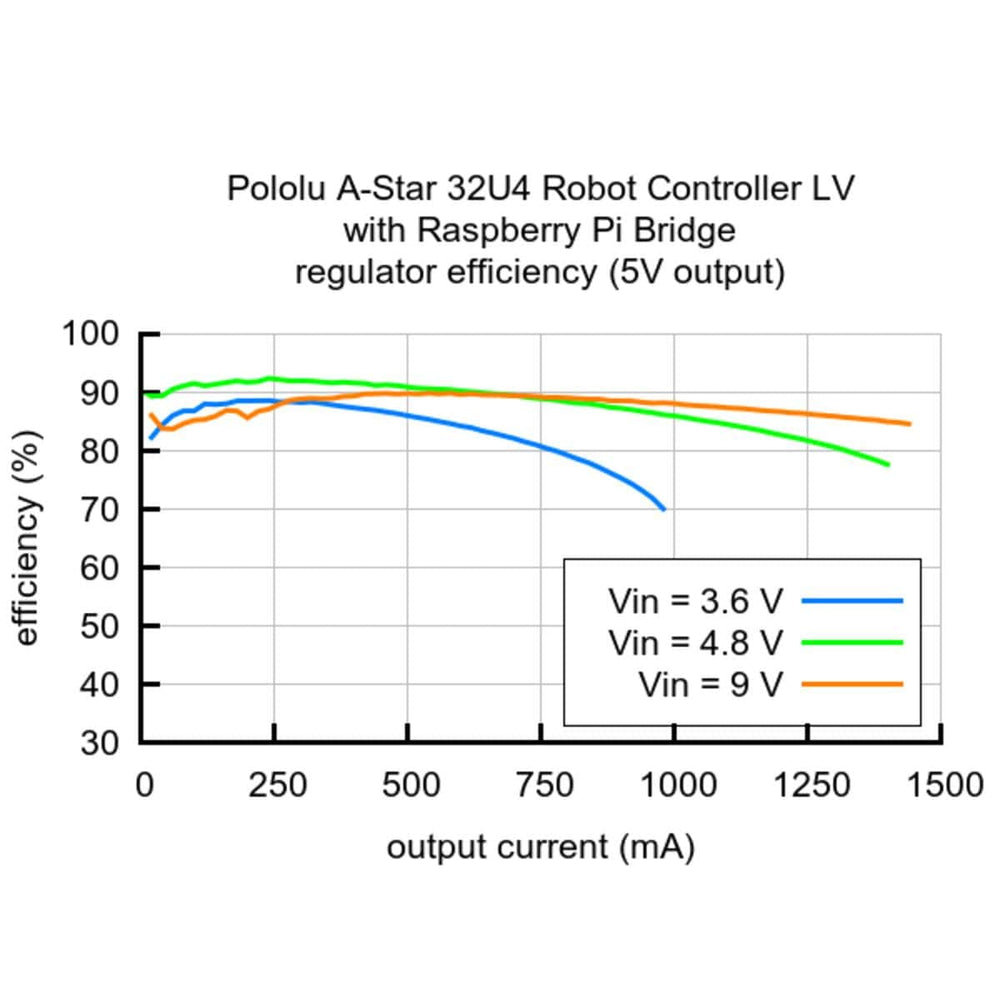
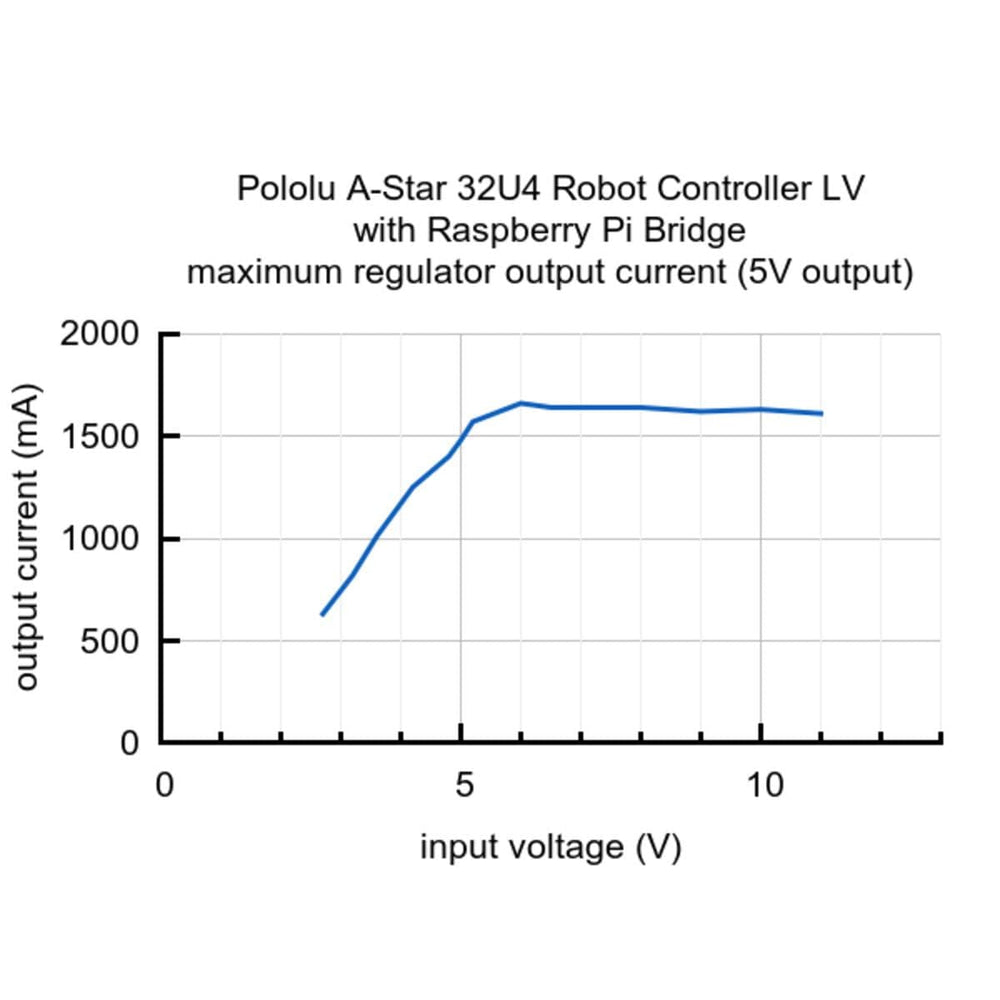
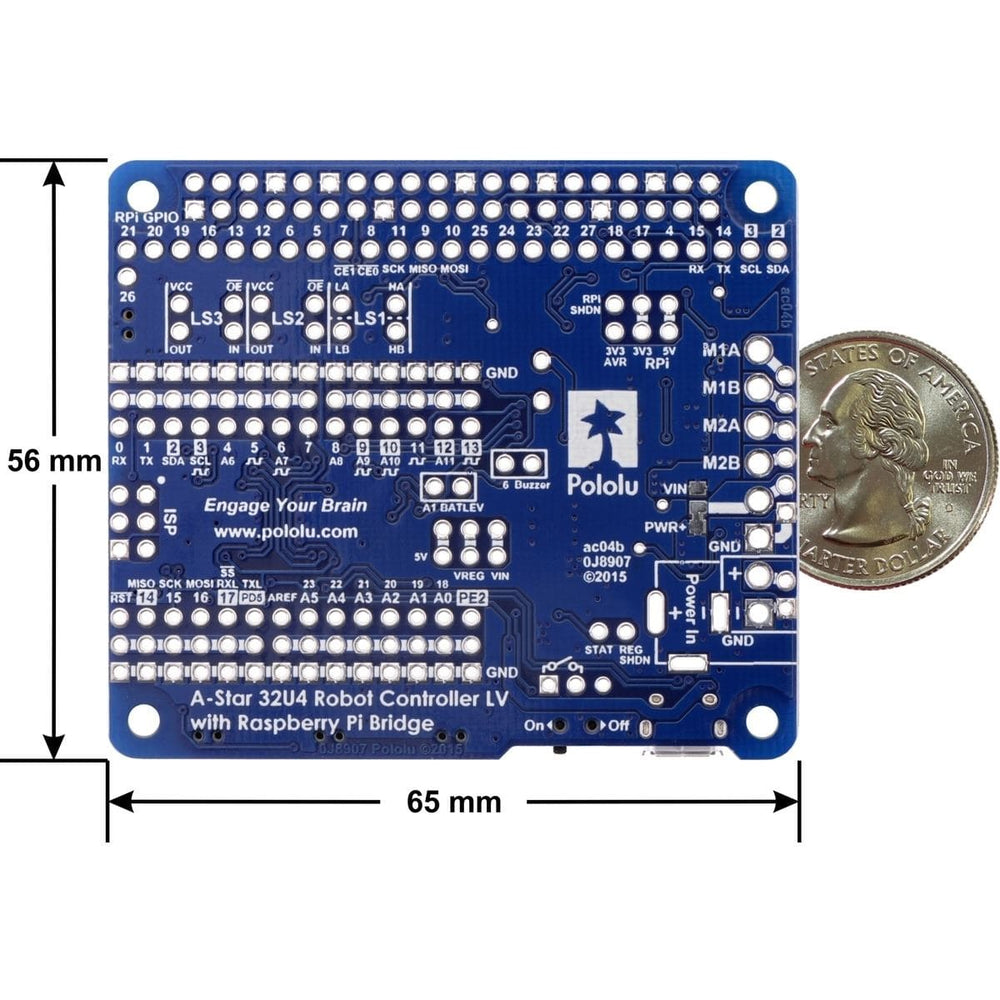
This programmable module combines with a Raspberry Pi (sold separately) to serve as the control centre of a small robot or electronics project.
Its ATmega32U4 AVR microcontroller comes preloaded with an Arduino-compatible bootloader, and the board includes dual motor drivers that can deliver 1.8 A per channel to two brushed DC motors. An efficient voltage regulator (2.7V to 11V input) and level shifters enable it to power and communicate with a Raspberry Pi.
This version of the A-Star 32U4 Robot Controller LV with Raspberry Pi Bridge is assembled with selected through-hole connectors and components for use as a Raspberry Pi expansion board.
A 2×20-pin 0.1″ female header is preinstalled to serve as a Raspberry Pi GPIO connector, and a 6-pin strip of terminal blocks and a DC power jack are mounted for motor and power connections. A buzzer is also installed, along with two 2×1-pin male headers and shorting blocks for the buzzer and battery level jumpers. It also ships with a set of four M2.5 standoffs (11 mm length), screws, and nuts that can be used to secure the board to the Raspberry Pi at the proper height for the GPIO connector.
Warning: You must never connect different power sources to multiple Power In locations at the same time, as doing so will create a short between the supplies.
The A-Star 32U4 Robot Controller LV with Raspberry Pi Bridge is a programmable module well-suited for robotics applications, designed to work either as an auxiliary controller mounted to a Raspberry Pi or as a standalone control solution for a small robot. This A-Star (abbreviated A*) is based on the ATmega32U4 AVR microcontroller from Microchip (formerly Atmel), which has built-in USB functionality, and it ships with a preloaded Arduino-compatible bootloader.
Its complement of peripheral hardware includes dual motor drivers capable of delivering a continuous 1.8 A per channel, along with pushbuttons, LEDs, and a buzzer for building a user interface. An efficient switching voltage regulator allows the controller to work over a wide range of input voltages (2.7V to 11V).
The robot controller board conforms to the Raspberry Pi HAT specification, allowing it to be used as an add-on for a Raspberry Pi with a 40-pin GPIO header . On-board level shifters make it easy to set up I²C communication and interface other signals between the two controllers, and the A-Star automatically supplies 5V power to an attached Raspberry Pi. In this setup, the Raspberry Pi can handle the high-level robot control while relying on the A-Star for low-level tasks like reading analog sensors and controlling timing-sensitive devices (e.g. servos).
We provide a library that helps establish communication between the A-Star and a Raspberry Pi, as well as a tutorial that demonstrates how to use the library and its included example code to build such a robot.
Our comprehensive user’s guide provides the basics you need to get started with the A-Star as well as detailed technical information for advanced users.
This product requires a USB A to Micro-B cable (not included) to connect to a computer.
A major feature of the A* Robot Controller LV is its power system, which allows it to efficiently operate from a 2.7V to 11V external source and provide power to an attached Raspberry Pi.
The input voltage is regulated to 5V by a TPS63061 switching step-up/step-down (buck-boost) converter from Texas Instruments. The regulator’s flexibility in input voltage is especially well-suited for battery-powered applications in which the battery voltage begins above 5V and drops below 5V as the battery discharges. Without the typical restriction on the battery voltage staying above 5 V throughout its life, a wider range of battery types can be considered. For example:
As shown in the graph in the product images, the LV’s 5V switching regulator has an efficiency – defined as (Power out)/(Power in) – of 80% to 90% for most combinations of input voltage and load.
The A-Star’s components, including the microcontroller and LEDs, draw 30 mA to 40 mA in typical applications (without the buzzer). The rest of the regulator’s achievable output current, which depends on input voltage as well as ambient conditions, can be used to power other devices; this can include an attached Raspberry Pi (which typically draws at least a few hundred milliamps, depending on model).
The blue line in the graph shows output currents at which the voltage regulator’s over-temperature protection typically kicks in after a few seconds. These currents represent the limit of the regulator’s capability and cannot be sustained for long periods; under typical operating conditions, a safe limit for the maximum continuous regulator output current is 60% to 70% of the values shown in the graph.
Like our other A-Star 32U4 programmable controllers, the A-Star 32U4 Robot Controller ships with a preloaded Arduino-compatible bootloader (which uses 4 KB of flash memory, leaving 28 KB available for the user program). We provide a software add-on that enables the board to be easily programmed from the Arduino environment and an Arduino library to make it easy to use the additional onboard hardware.
The A-Star 32U4 Robot Controller has the same microcontroller as the Arduino Leonardo and Arduino Micro, and it runs at the same frequency, so most code examples intended for those boards should also work on the A-Star.
| Processor: | ATmega32U4 @ 16 MHz |
| RAM size: | 2560 bytes |
| Program memory size: | 32 Kbytes2 |
| Motor driver: | DRV8838 |
| Motor channels: | 2 |
| User I/O lines: | 263 |
| Input voltage range: | 2.7 V to 11 V |
| Minimum operating voltage: | 2.7 V |
| Maximum operating voltage: | 11 V |
| Maximum output current: | 1.5 A4 |
| Continuous output current per channel: | 1.8 A |
| Peak output current per channel: | 1.8 A |
| Logic voltage: | 5 V |
| Reverse voltage protection?: | Y |
| External programmer required?: | N |
The A-Star 32U4 Robot Controller is a part of our larger A-Star 32U4 family, all of whose members are based on the same ATmega32U4 microcontroller, feature native USB interfaces, and are preloaded with Arduino-compatible bootloaders.











